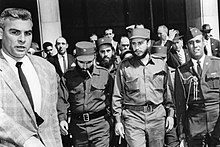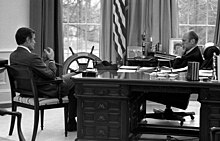CIA assassination attempts on Fidel Castro
The United States' Central Intelligence Agency (CIA) made numerous unsuccessful attempts to assassinate Cuban leader Fidel Castro.
[6][7] Attorney Robert Maheu, who was working as a CIA cutout at the time, was identified as the team leader, who recruited John Roselli, a gambler with contacts in the Italian American Mafia and Cuban underworlds.
[8] According to the CIA documents, the so-called Family Jewels that were declassified in 2007, one assassination attempt on Fidel Castro prior to the Bay of Pigs invasion involved noted American mobsters John Roselli, Sam Giancana and Santo Trafficante.
In September 1960, Momo Salvatore Giancana, a successor of Al Capone's in the Chicago Outfit, and Miami Syndicate leader Santo Trafficante, who were both on the FBI's Ten Most Wanted list at that time, were indirectly contacted by the CIA about the possibility of Fidel Castro's assassination.
[12][13][14] Allegedly, after several unsuccessful attempts to introduce the poison into Castro's food, Orta abruptly demanded to be let out of the mission, handing over the job to another unnamed participant.
However, the second assassination attempt was apparently thwarted when Castro stopped visiting the restaurant that had the botulinum toxin poison pills, and was cancelled due to the launching of the Bay of Pigs Invasion.
[15][13] According to Top Secret transcripts declassified in 2021, Scott Breckinridge, in his 1975 Church Committee hearing told senators that the CIA had also contemplated using botulinum toxin to lace cigars to be delivered to Castro, but this plan never went forward.
[15] On October 26, 2017, during the presidency of Donald Trump, declassified documents revealed that US Attorney General Robert Kennedy hesitated to recruit the Mafia in assassination attempts on Castro due to his push against organized crime.
[3]: 71 Fabián Escalante, a retired chief of Cuba's counterintelligence, who had been tasked with protecting Castro, estimated the number of assassination schemes or actual attempts by the Central Intelligence Agency to be 638, a project code-named Executive Action, and split them among U.S. administrations as follows: Dwight D. Eisenhower, 38; John F. Kennedy, 42; Lyndon B. Johnson, 72; Richard Nixon, 184; Jimmy Carter, 64; Ronald Reagan, 197; George H. W. Bush, 16; Bill Clinton, 21.
[19][24] Some plots aimed not at murder but at character assassination; they, for example, involved using thallium salts to destroy Castro's famous beard,[4]: 30 or lacing his radio studio with LSD to cause him disorientation during the broadcast and damage his public image.
[27][28] The Church Committee rejected political assassination as a foreign policy tool and declared that it was "incompatible with American principle, international order, and morality.
"[29] For many years the New York Times kept an obituary ready for Fidel Castro in its composing room, already locked on a "turtle" (flat table) for instant printing in the event of his assassination.
Castro eventually survived so many assassination attempts that the hot metal typesetting process became outdated and the turtle was moved to the office of William Safire, where it remained as of 1990.



